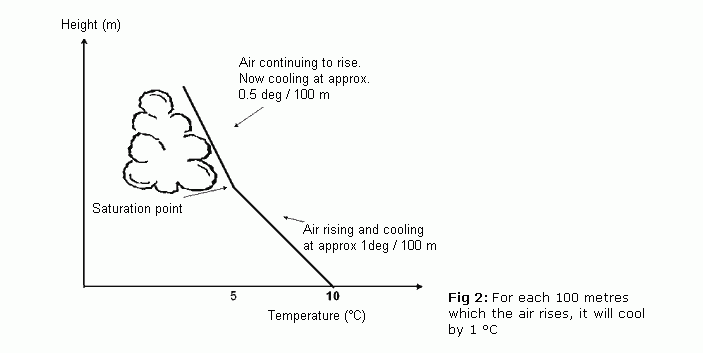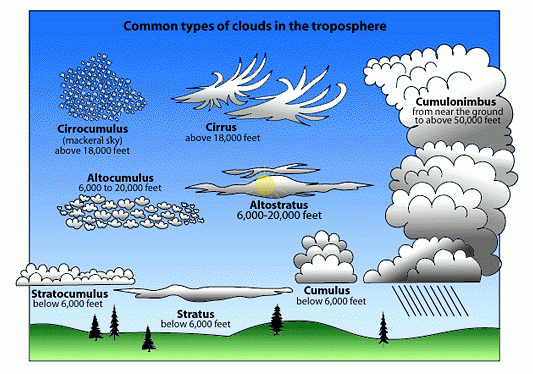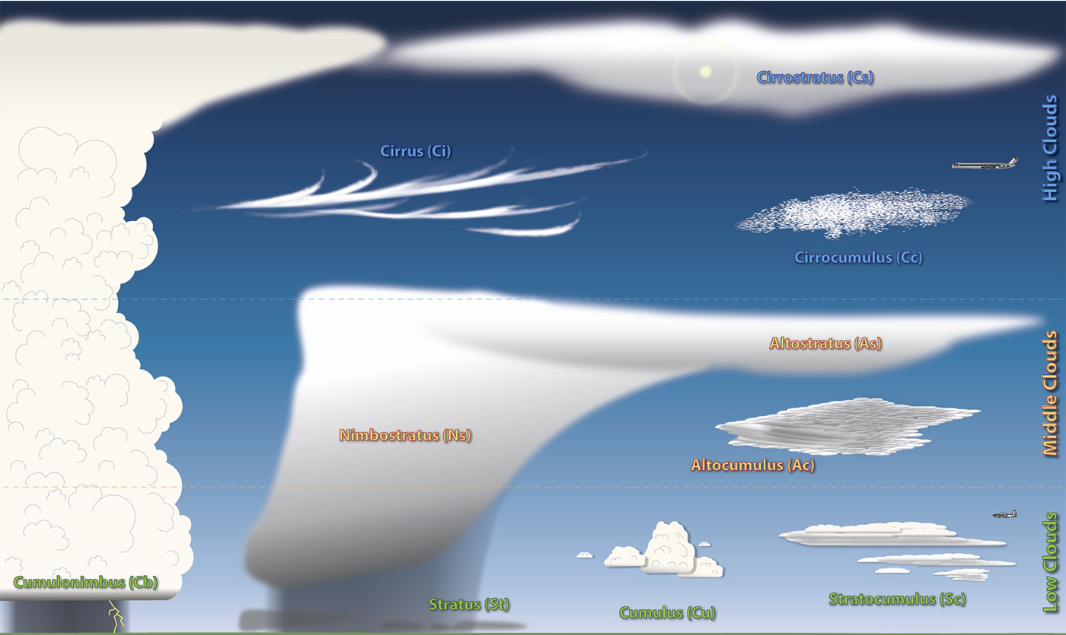| ANOTHER CLOUD TUTORIAL |
What causes clouds?
What influences the color of clouds?
Why do clouds stop growing upwards?
Why are there no clouds on some days?
Types of clouds
Low clouds
Medium clouds
High clouds
Measuring clouds
The formation of precipitation
What causes clouds?
A cloud is defined as 'a visible aggregate of minute droplets of water or particles of ice or a mixture of both floating in the free air'. Each droplet has a diameter of about a hundredth of a millimeter and each cubic meter of air will contain 100 million droplets. Because the droplets are so small, they can remain in liquid form in temperatures of -30 °C. If so, they are called supercooled droplets.
Clouds at higher and extremely cold levels in the atmosphere are composed of ice crystals - these can be about a tenth of a millimeter long.
Clouds form when the invisible water vapor in the air condenses into visible water droplets or ice crystals. For this to happen, the parcel of air must be saturated, i.e. unable to hold all the water it contains in vapor form, so it starts to condense into a liquid or solid form. There are two ways by which saturation is reached.
(a) By increasing the water content in the air, e.g. through evaporation, to a point where the air can hold no more.
(b) By cooling the air so that it reaches its dew point - this is the temperature at which condensation occurs, and is unable to 'hold' any more water. Figure 1 shows how there is a maximum amount of water vapor the air, at a given temperature, can hold. In general, the warmer the air, the more water vapor it can hold. Therefore, reducing its temperature decreases its ability to hold water vapor so that condensation occurs.
Method (b) is the usual way that clouds are produced, and it is associated with air rising in the lower part of the atmosphere. As the air rises it expands due to lower atmospheric pressure, and the energy used in expansion causes the air to cool. Generally speaking, for each 100 meters/330 feet which the air rises, it will cool by 1 °C, as shown in Figure 2. The rate of cooling will vary depending on the water content, or humidity, of the air. Moist parcels of air may cool more slowly, at a rate of 0.5 ° C per 100 meters/330 feet.


Therefore, the vertical ascent of air will reduce its ability to hold water vapor, so that condensation occurs. The height at which dew point is reached and clouds form is called the condensation level.
There are five factors which can lead to air rising and cooling:
1. Surface heating. The ground is heated by the sun which heats the air in contact with it causing it to rise. The rising columns are often called thermals.2. Topography. Air forced to rise over a barrier of mountains or hills. This is known as orographic uplift.
3. Frontal. A mass of warm air rising up over a mass of cold, dense air. The boundary is called a 'front'.
4. Convergence. Streams of air flowing from different directions are forced to rise where they meet.
5. Turbulence. A sudden change in wind speed with height creating turbulent eddies in the air.
Another important factor to consider is that water vapor needs something to condense onto. Floating in the air are millions of minute salt, dust and smoke particles known as condensation nuclei which enable condensation to take place when the air is just saturated.
What influences the color of clouds?
Light from both the sky and from clouds is sunlight which has been scattered. In the case of the sky, the molecules of air (nitrogen and oxygen) undertake the scattering, but the molecules are so small that the blue part of the spectrum is scattered more strongly than other colors.
The water droplets in the cloud are much larger, and these larger particles scatter all of the colors of the spectrum by about the same amount, so white light from the sun emerges from the clouds still white.
Sometimes, clouds have a yellowish or brownish tinge - this is a sign of air pollution.
Why do clouds stop growing upwards?
Condensation involves the release of latent heat. This is the 'invisible' heat which a water droplet 'stores' when it changes from a liquid into a vapor. Its subsequent change of form again releases enough latent heat to make the damp parcel of air warmer than the air surrounding it. This allows the parcel of air to rise until all of the 'surplus' water vapor has condensed and all the latent heat has been released.
Therefore, the main reason which stops clouds growing upwards is the end of the release of latent heat through the condensation process. There are two other factors which also play a role. Faster upper atmospheric winds can plane off the tops of tall clouds, whilst in very high clouds, the cloud might cross the tropopause, and enter the stratosphere where temperatures rise, rather than decrease, with altitude. This thermal change will prevent further condensation.
Why are there no clouds on some days?
Even when it is very warm and sunny, there might not be any clouds and the sky is a clear blue. The usual reason for the absence of clouds will be the type of pressure, with the area being under the influence of a high pressure or anticyclone. Air would be sinking slowly, rather than rising and cooling. As the air sinks into the lower part of the atmosphere, the pressure rises, it becomes compressed and warms up, so that no condensation takes place. In simple terms, there are no mechanisms for clouds to form under these pressure conditions.
Types of clouds
In 1803 a retail chemist and amateur meteorologist called Luke Howard proposed a system which has subsequently become the basis of the present international classification. Howard also become known by some people as "the father of British meteorology", and his pioneering work stemmed from his curiosity into the vivid sunsets in the late 18th century following a series of violent volcanic eruptions. They had ejected dust high up into the atmosphere, thereby increasing the amount of condensation nuclei, and producing spectacular cloud formations and sunsets.
Howard recognised four types of cloud and gave them the following Latin names:
Cumulus - heaped or in a pileStratus - in a sheet or layer
Cirrus - thread-like, hairy or curled
Nimbus - a rain bearer
If we include another Latin word altum meaning height, the names of the ten main cloud types are all derived from these five words and based upon their appearance from ground level and visual characteristics.
The cloud types are split into three groups according to the height of their base above mean sea level. Note that 'medium' level clouds are prefixed by the word alto and 'high' clouds by the word cirro (see Table 1). All heights given are approximate above sea level in mid-latitudes. If observing from a hill top or mountain site, the range of bases will accordingly be lower.
Low clouds Surface - 7,000 ftMedium clouds 7,000 - 17,000 ft
High clouds 17,000 - 35,000 ft
LOW CLOUDS
Cumulus (Cu)
Height of base: 1,200-6,000 ft
Color: White on its sunlit parts but with darker undersides.
Shape: This cloud appears in the form of detached heaps. Shallow cumulus may appear quite ragged, especially in strong winds, but well formed clouds have flattened bases and sharp outlines. Large cumulus clouds have a distinctive "cauliflower" shape.
Other features: Well developed cumulus may produce showers.
Cumulonimbus (Cb)
Height of base: 1,000-5,000 ft
Color: White upper parts with dark, threatening undersides.
Shape: A cumulus-type cloud of considerable vertical extent. When the top of a cumulus reaches great heights, the water droplets are transformed into ice crystals and it loses its clear, sharp outline. At this stage the cloud has become a cumulonimbus. Often, the fibrous cloud top spreads out into a distinctive wedge or anvil shape.
Other features: Accompanied by heavy showers, perhaps with hail and thunder. By convention Cb is usually reported if hail or thunder occur, even if the observer does not immediately recognise the cloud as Cb; (it may be embedded within layers of other cloud types).
Stratus (St)
Height of base: surface-1,500 ft
Color: Usually grey.
Shape: May appear as a layer with a fairly uniform base or in ragged patches, especially during precipitation falling from a cloud layer above. Fog will often lift into a layer of stratus due to an increase in wind or rise in temperature. As the sun heats the ground the base of stratus cloud may rise and break becoming shallow cumulus cloud as its edges take on a more distinctive form.
Other features: If thin, the disc of the sun or moon will be visible (providing there are no other cloud layers above). If thick, it may produce drizzle or snow grains.
Stratocumulus (Sc)
Height of base: 1,200-7,000 ft
Color: Grey or white, generally with shading.
Shape: Either patches or a sheet of rounded elements but may also appear as an undulating layer. When viewed from the ground, the size of individual elements will have an apparent width of more than 5degree when at an elevation greater than 30degree (the width of 3 fingers at arm's length).
Other features: May produce light rain or snow. Sometimes the cloud may result from the spreading out of cumulus, giving a light shower.
MEDIUM CLOUDS
Altocumulus (Ac)
Height of base: 7,000-17,000 ft
Color: Grey or white, generally with some shading.
Shape: Several different types, the most common being either patches or a sheet of rounded elements but may also appear as a layer without much form. When viewed from the ground, the size of individual elements will have an apparent width of 1 to 5degree when at an elevation greater than 30degree (the width of 1 to 3 fingers at arm's length). Even if the elements appear smaller than this the cloud is still classified altocumulus if it shows shading.
Other features: Occasionally some slight rain or snow, perhaps in the form of a shower may reach the ground. On rare occasions, a thunderstorm may occur from one type of Ac known as altocumulus castellanus so called because in outline, the cloud tops look like a series of turrets and towers along a castle wall.
Altostratus (As)
Height of base: 8,000-17,000 ft
Color: Greyish or bluish.
Shape: A sheet of uniform appearance totally or partly covering the sky.
Other features: Sometimes thin enough to reveal the sun or moon vaguely, as through ground glass. Objects on the ground do not cast shadows. May give generally light rain or snow, occasionally ice pellets, if the cloud base is no higher than about 10,000 ft.
Nimbostratus (Ns)
Height of base: 1,500-10,000 ft
Color: Dark grey.
Shape: A thick, diffuse layer covering all or most of the sky. Other features: Sun or moon always blotted out. Accompanied by moderate or heavy rain or snow, occasionally ice pellets. Although classed as a medium cloud, its base frequently descends to low cloud levels. May be partly or even totally obscured by stratus forming underneath in precipitation.
HIGH CLOUDS
Cirrus (Ci)
Height of base: 17,000-35,000 ft
Color: Composed of ice crystals, therefore white.
Shape: Delicate hair-like filaments, sometimes hooked at the end; or in denser, entangled patches; or occasionally in parallel bands which appear to converge towards the horizon. Other features: The remains of the upper portion of a cumulonimbus is also classified as cirrus.
Cirrocumulus (Cc) Height of base: 17,000-35,000 ft
Color: Composed of ice crystals, therefore white.
Shape: Patches or sheet of very small elements in the form of grains or ripples or a honeycomb. When viewed from the ground, the size of individual elements will have an apparent width of less than 1degree when at an elevation greater than 30degree (no greater than the width of a little finger at arm's length).
Other features: Sometimes its appearance in a regular pattern of 'waves' and small gaps may resemble the scales of a fish, thus giving rise to the popular name 'mackerel sky'. (this name may also be attributed to high altocumulus clouds).
Cirrostratus (Cs) Height of base: 17,000-35,000 ft
Color: Composed of ice crystals, therefore white.
Shape: A transparent veil of fibrous or smooth appearance totally or partly covering the sky.
Other features: Thin enough to allow the sun to cast shadows on the ground unless it is low in the sky. Produces halo phenomena, the most frequent being the small (22degree ) halo around the sun or moon a little more than the distance between the top of the thumb and the little finger spread wide apart at arm's length.
Condensation trails (contrails)
These are thin trails of condensation, formed by the water vapor rushing out from the engines of jet aircraft flying at high altitudes. They are not true clouds, but can remain in the sky for a long time, and grow into cirrus clouds.
Measuring clouds
The cloud amount is defined as 'the proportion of the celestial dome which is covered by cloud. The scale used is eighths, or oktas, with observers standing in an open space or on a rooftop to get a good view or panorama of the sky.
Complete cloud cover is reported as 8 oktas, half cover as 4 oktas, and a completely clear sky as zero oktas. If there is low-lying mist or fog, the observer will report sky obscured.
The reporter will also report the amount of each cloud level 2 oktas of cumulus and 3 oktas of cirrus, etc.
The frequent passage of depressions across the United Kingdom means that the most commonly reported cloud amount is, not surprisingly, 8 oktas. A clear blue sky, i.e. zero oktas, is less common, as often on hot, sunny days, there are small wispy layers of cirrostratus or fine tufts of thin cirrus at high altitudes.
The formation of precipitation
Cooling, condensation and cloud formation is the start of the process which results in precipitation. But not all clouds will produce raindrops or snowflakes many are so short-lived and small that there are no opportunities for precipitation mechanisms to start.
There are two theories that explain how minute cloud droplets develop into precipitation.
1. The Bergeron-Findeisen ice-crystal mechanism
If parcels of air are uplifted to a sufficient height in the troposphere, the dew point temperature will be very low, and minute ice crystals will start to form. The supercooled water droplets will also freeze on contact with these ice nuclei.
The ice crystals subsequently combine to form larger flakes which attract more supercooled droplets. This process continues until the flakes fall back towards the ground. As they fall through the warmer layers of air, the ice particles melt to form raindrops. However, some ice pellets or snowflakes might be carried down to ground level by cold downdraughts.
2. Longmuir's collision and coalescence theory
This applies to 'warm' clouds i.e. those without large numbers of ice crystals. Instead they contain water droplets of many differing sizes, which are swept upwards at different velocities so that they collide and combine with other droplets.
It is thought that when the droplets have a radius of 3 mm, their movement causes them to splinter and disintegrate, forming a fresh supply of water droplets.
Man-made rain
In recent years, experiments have taken place, chiefly in the USA and the former USSR, adding particles into clouds that act as condensation or freezing nuclei. This cloud seeding involves the addition into the atmosphere from aircraft of dry ice, silver iodide or other hygroscopic substances. These experiments have largely taken place on the margins of farming areas where rainfall is needed for crop growth.


